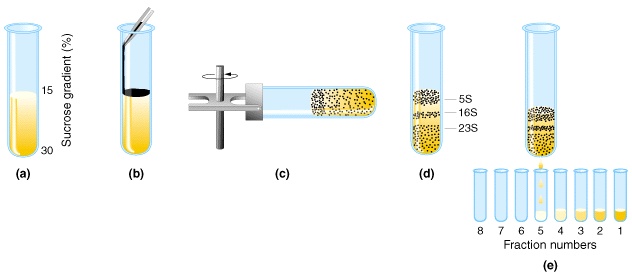
Sucrose-Gradient Technique for determination of sedimentation coefficients (S)

(a) A sucrose gradient,
with continuously variable concentration of sucrose, is prepared in a
centrifuge tube. The technique is similar to that used in making Irish
coffee. (b) A sample of
macromolecules
is layered over the pre-formed sucrose gradient. (c) The
tube is
placed
in an ultracentrifuge and spun at high speed for several hours;
the sucrose gradient remains stable. (d) Depending on the sizes
& molecular weights of the macromolecular components, they migrate
("sediment") through the gradient at
different rates: lighter
molecules
will move less quickly than more dense, compact molecules. Each
molecular type will eventually form a discrete band at its isopycnic point,
where its density equals that of the sucrose gradient. (e) The
fractions can be recovered by
poking
a hole in the bottom of the centrifuge tube, and collecting a series of
samples as a predetermined number of drops. The sample tubes are
numbered in order from lighter to heavier.
In early experiments with rRNA molecules, the various components were described according to the number of the sample tube in which they appeared. Small rRNA subunits appeared in fraction 5, and were designated as 5S , while large rRNA subunits appeared in fractions 16 & 23, and were designated 16S or 23S. These were subsequently designated as Svedberg units (S).
Density gradient techniques can be used to separate other types of molecules, for example DNA molecules that vary in [G+C] content, and may employ other gradient substances, such as cesium chloride.